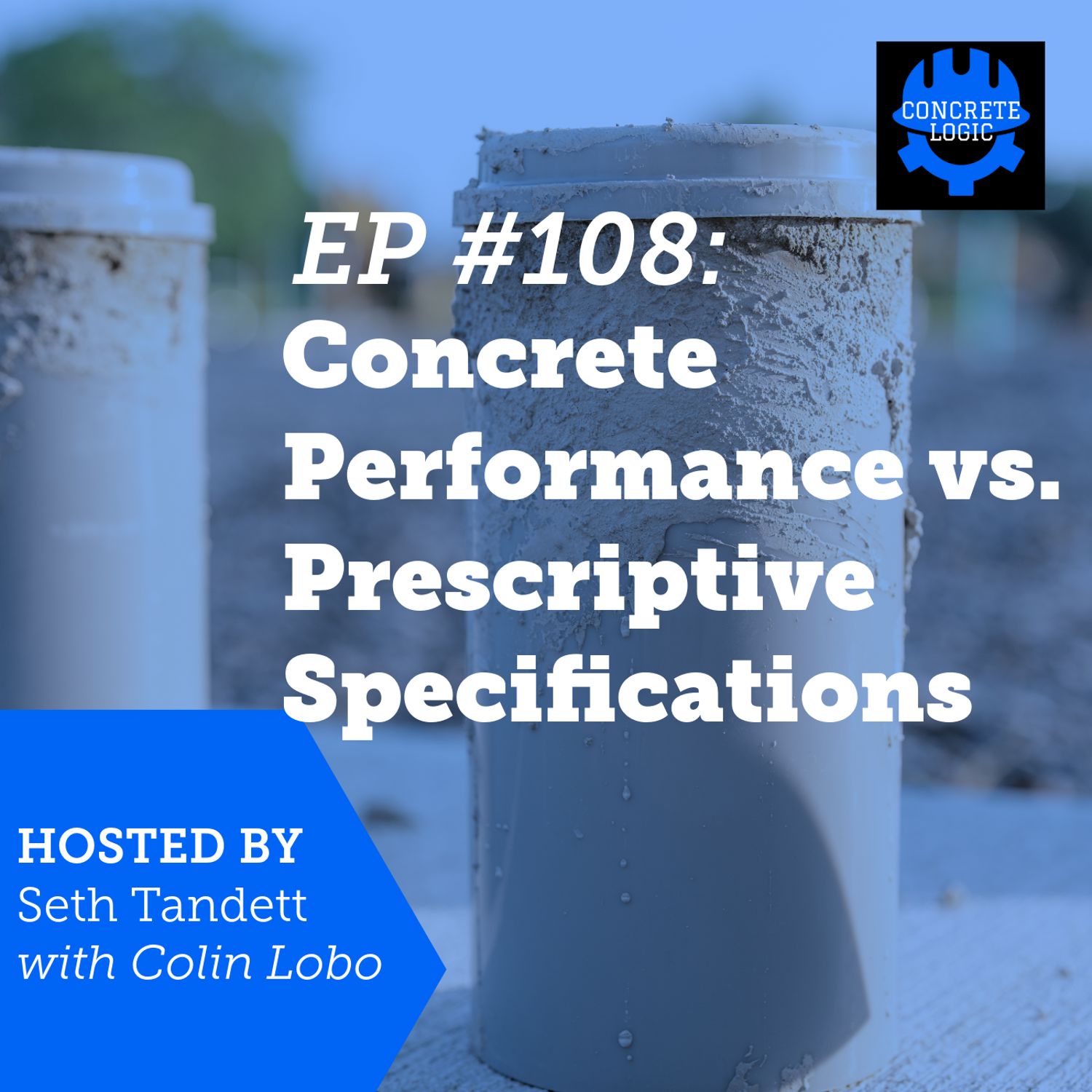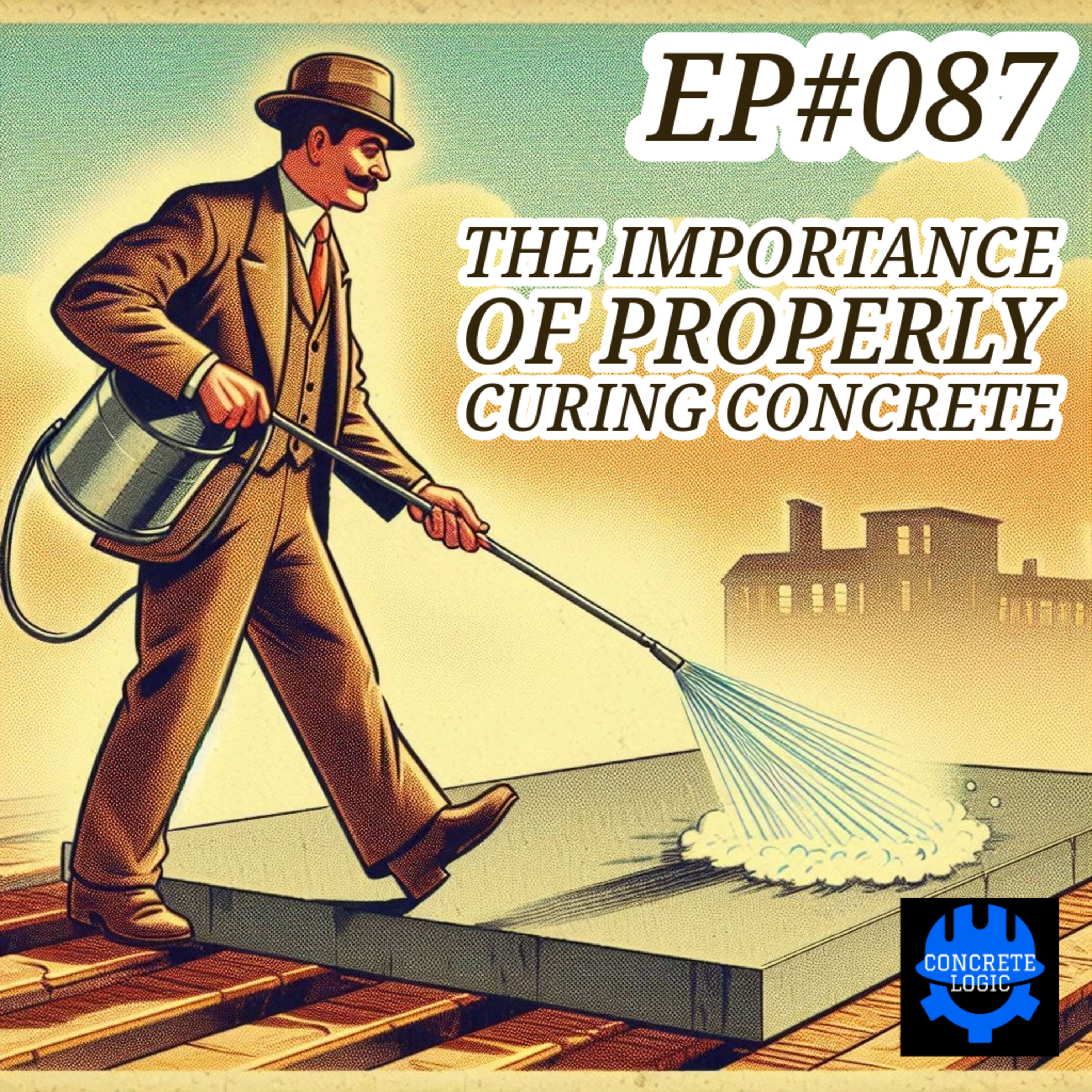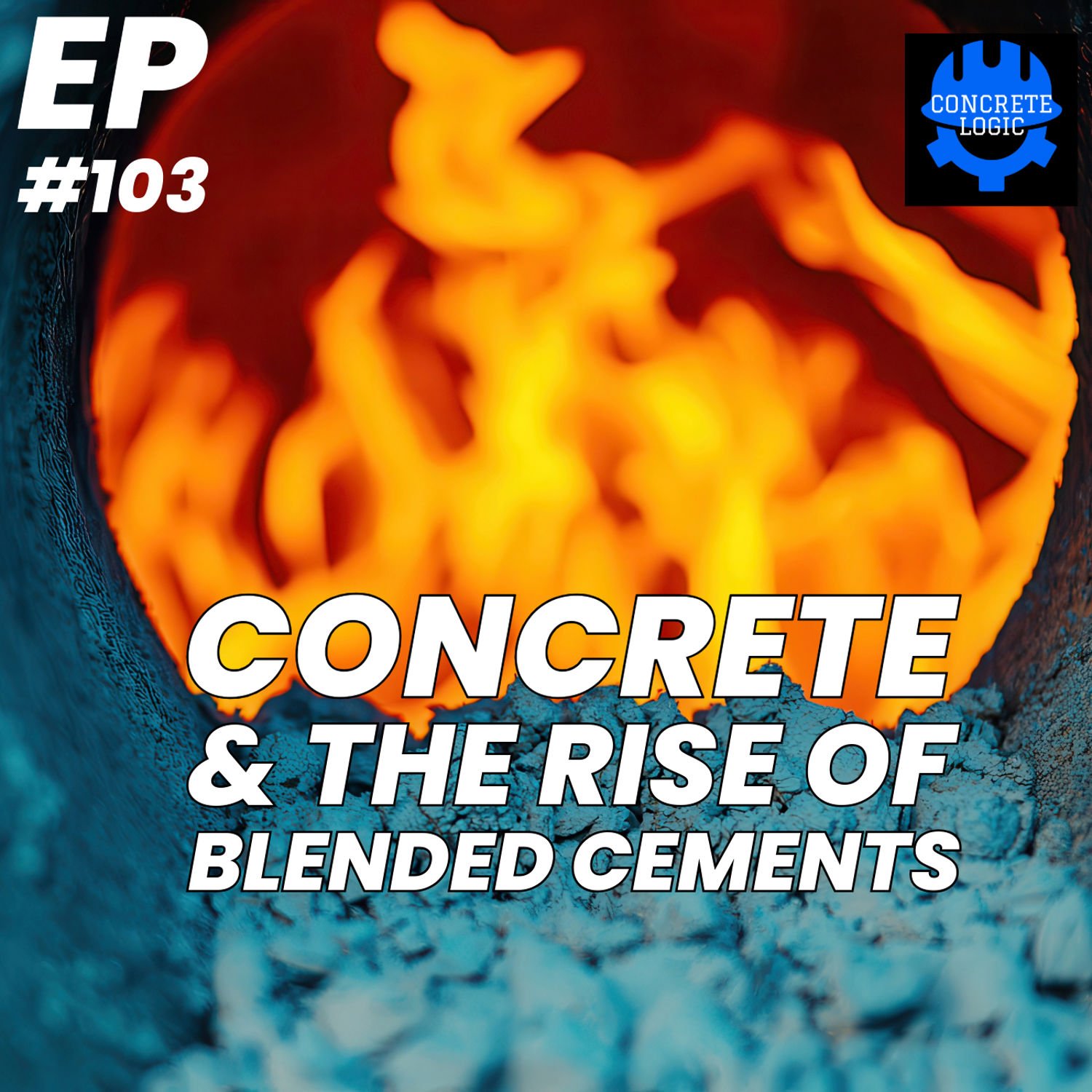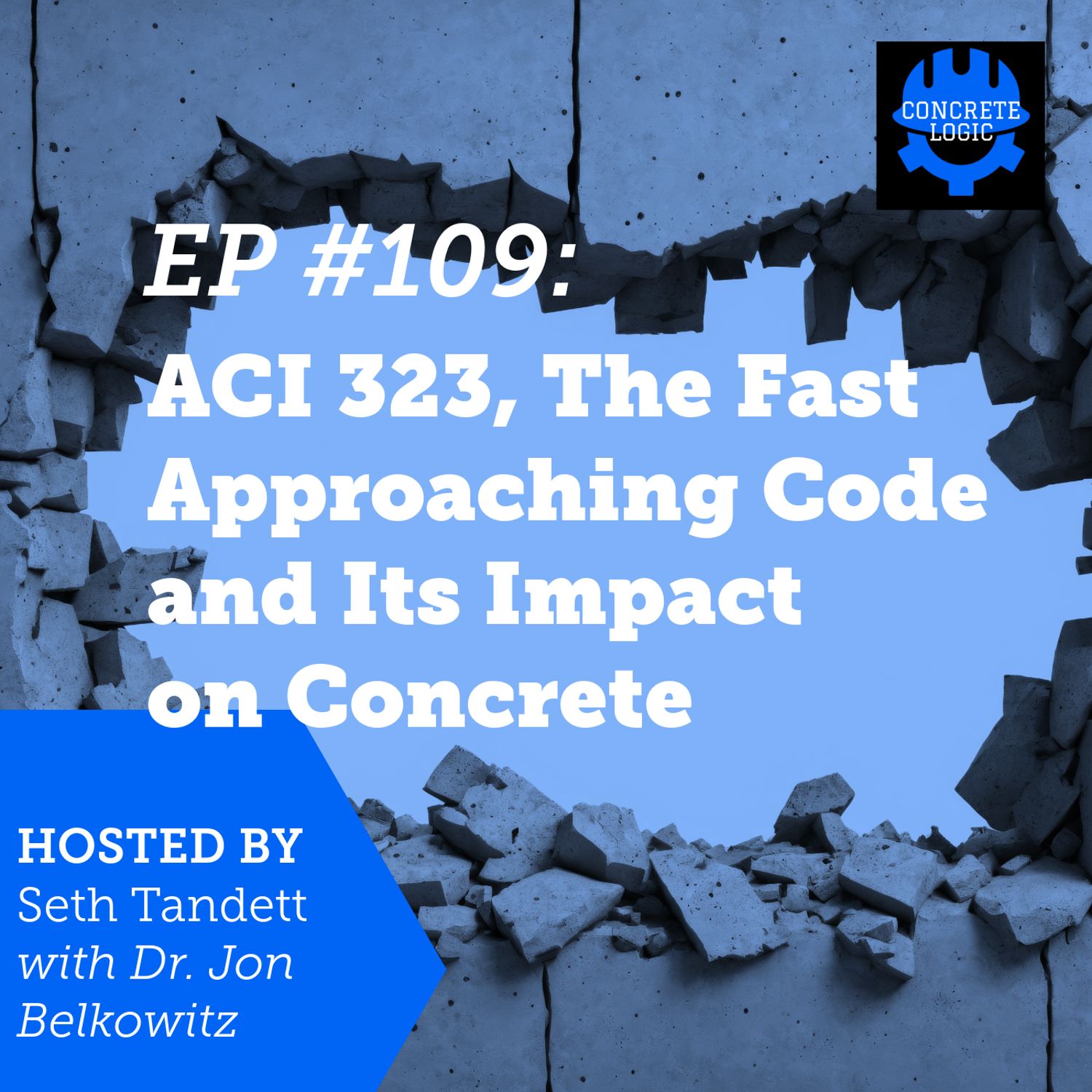EP #108: Concrete Performance vs. Prescriptive Specifications

In this episode of the Concrete Logic Podcast, Seth Tandett interviews Colin Lobo, the Executive Vice President and Division Head of Engineering at NRMCA. They delve into the differences between prescriptive and performance specifications in concrete, discussing the implications of each on responsibility, compliance, and industry practices. Colin explains the evolution from prescriptive to performance specifications, the challenges of hybrid specifications, and the importance of accurate documentation in concrete mixing. The conversation highlights the challenges faced in job site testing, the importance of density measurement, and the need for improved testing standards to ensure safety and sustainability. The discussion also touches on the shift towards performance-based specifications and the confidentiality issues surrounding mix designs.
Takeaways
• Prescriptive specifications dictate how to mix concrete.
• Performance specifications focus on the desired outcomes.
• Responsibility shifts to the concrete producer with performance specs.
• Hybrid specifications can create contradictions in requirements.
• Water quality is a significant concern in concrete mixing.
• Testing specimens often get compromised, affecting strength measurements.
• Current testing standards are inadequate and need improvement.
• Sustainability efforts could be increasing the carbon footprint of concrete.
• Industry standards must evolve to reflect practical realities.
• Collaboration is needed to improve testing and standards.
• Engagement in standards committees is vital for industry progress.
Chapters
00:00 Introduction to Concrete Specifications
03:25 Understanding Prescriptive vs Performance Specifications
07:30 The Shift in Responsibility
09:50 Hybrid Specifications and Their Challenges
11:46 The Role of Legal in Specification Acceptance
13:24 Concrete Producer's Perspective on Specifications
15:09 Documenting Compliance in Concrete Mixing
16:40 Typical Prescriptive Requirements
19:24 Evolution from Prescriptive to Performance Specifications
21:20 Challenges in Concrete Testing
24:29 Mix Design and Performance Expectations
27:27 The Importance of Density Measurement
29:52 Addressing Testing Standards and Sustainability
32:19 Evolving Towards Performance-Based Specifications
35:18 Confidentiality and Industry Standards
***
Did you learn something from this episode? Would you like to support the concrete industry's favorite podcast?
If so, donate at https://www.concretelogicpodcast.com/support/ .
When YOU donate to the show, you will be listed as a producer of the next episode that is released!
Join the Concrete Logic Academy! Enhance your learning from our podcast with engaging quizzes that test your knowledge and help you earn Professional Development Hours (PDHs). Support Concrete Logic and take your education to the next level! 🚀
FIND OUT MORE HERE: https://www.concretelogicacademy.com/
***
Episode References
Guest: Colon Lobo, Executive VP of NRMCA, clobo@nrmca.org
Guest Website: https://www.nrmca.org/
Producers: Jodi Tandett, Mike Hernandez
Donate & Become a Producer: https://www.concretelogicpodcast.com/support/
Music: Mike Dunton | https://www.mikeduntonmusic.com | mikeduntonmusic@gmail.com | Instagram @Mike_Dunton
Host: Seth Tandett, seth@concretelogicpodcast.com
Host LinkedIn: https://www.linkedin.com/in/seth-tandett/
Website: https://www.concretelogicpodcast.com/
LinkedIn: https://www.linkedin.com/company/concrete-logic-podcast
***
Why join the Concrete Logic Academy? You get access to:
• Hands-On Video Courses: Dive into one of our many educational video courses. Each course breaks down complex topics related to concrete construction into easy-to-understand modules, accompanied by visuals. These knowledge-packed materials not only enrich your understanding but also make it enjoyable and engaging.
• Live Q&A Sessions: Attend our exclusive live Q&A sessions. Every session is hosted by industry leaders with years of expertise in concrete construction. These interactions provide opportunities to get your queries addressed in real-time, fostering a deeper understanding of the subject.
• Collaborative Projects: Take part in our groundbreaking collaborative projects. Here, you get to apply the knowledge you’ve gained from the courses and Q&A sessions, work with other community members, and create innovative solutions for the concrete industry. Experience the satisfaction that comes with problem-solving and contributing to the industry.
• Live Podcast Recordings: Experience the thrill of live learning by joining exclusive, real-time recordings of the Concrete Logic Podcast, where industry leaders unveil cutting-edge insights and groundbreaking innovations.
• Concrete Library: Access eBooks, Expert Articles, Academic Papers, and Industry Archives. These resources propel your learning journey, offering knowledge tailored to students, researchers, and professionals.
• Dynamic Growth Hub: Secure your spot at today's membership price in the ever-growing Concrete Logic Academy, where you'll gain access to an expanding library of courses, publications, and resources. Join now and benefit from our continuous growth before prices rise!
Learn more: https://www.concretelogicacademy.com/
Seth Tandett (00:01.586)
Welcome to another episode of the Concrete Logic Podcast. And today I have Colin Lobo with me. He is the executive vice president and division head of engineering at National Ready Mixed Concrete Association, NRMCA. Dr. Lobo, he oversees the research and engineering department at NRMCA and he leads initiatives to improve concrete quality, sustainability and performance.
His work includes developing technical guidelines, conducting research and representing the industry in various codes and standards. And he's a concrete educator as well. So that's why he's here today. And we're going to talk about prescriptive specifications versus performance specifications, which is a topic that has, I guess, come about again recently with our
changes in our material. So, but before we get started, I just want to remind everybody how you can support concrete logic. There's several ways you can do that. First way is if you enjoy the episode today and you learn something from it, please share this with a colleague or a coworker. We're on every platform. So there's no excuse for folks not to listen to us. So if you hear something that was intriguing or you learn something, don't be selfish and share it.
the next way you can support the show is if you go to concrete logic podcast.com, there are a couple of ways of getting ahold of me. There's a contact button in the upper right-hand corner. click on that. It's like sending me an email or in the bottom right-hand corner, you could click on the microphone and that will record a voicemail. it'll send me a voicemail. so the, the, we're looking for there are topic.
or guest suggestions. Colin was a suggestion from a listener. So that's how it works. You tell me what you want to hear, what topics you want to hear, or who you want to hear from, and I will chase them down. The next way you can support the show is there's a donation button on the home page of ConcreteLogicPodcast.com. So if you feel like there's a dollar amount that the episode has worked to you, you
Seth Tandett (02:27.196)
click on there and you give any amount which is fantastic any amount is appreciated or you can join us at ConcreteLogicAcademy.com that's a new spot that we've started that you can join other folks that are passionate about concrete where we're sharing ideas or discussing things maybe that we don't want to discuss out in
public, we could discuss it amongst ourselves. You can join that as well. So check that out ConcreteLogicAcademy.com. Colin, I think a good spot to start today is if you could define for us what a prescriptive specification is and what a performance
specification is and then we'll go from there. Very good Seth, thanks for having me. I appreciate the invitation and the opportunity to talk a little bit about specifications. So concrete is probably, as everybody says, the largest construction material used in the world. It is sort of like baking a cake where you use the flour as cement.
Colin Lobo (03:29.553)
Very good, Seth. Thanks for having me. I appreciate the invitation and the opportunity to talk a little bit about specifications. So concrete is probably, as everybody says, the largest construction material used in the world. It is sort of like baking a cake. We use the flour as cement.
Seth Tandett (03:55.096)
and the nuts and fruitcakes as the aggregates and put a little bit of water, mix it all up, and you get a product that can be customized to a wide range of tastes, strengths, durability, et cetera. So it's a pretty interesting material. So traditionally, we have been essentially targeted to
Colin Lobo (03:55.911)
nuts and fruitcakes as the aggregates and put a little bit water, mix it all up. And you get a product that can be customized to a wide range of tastes, strengths.
durability, et cetera. So it's a pretty interesting material. So traditionally, we have been essentially targeted to develop concrete mixtures by a purchaser or a designer telling us how to put that cake together. So they tell us that we need to use so much cement.
Seth Tandett (04:23.28)
Develop concrete mixtures by a purchaser or a designer telling us how to put that cake together. Okay, so they tell us that we need to use so much cement. We can't use these things. We need to certain requirements on that. Exactly how much water we need to use, what the consistency has to come up as.
Colin Lobo (04:39.677)
We can't use these things. We need to meet certain requirements on that. Exactly how much water we need to use, what the consistency has to come up as. And then eventually they expect that it meets some performance such as strength, shrinkage, durability, et cetera.
Seth Tandett (04:50.822)
And then eventually they expect that it meets some performance such as strength, shrinkage, durability, et cetera.
Colin Lobo (05:02.609)
And that has worked for a while because it has some history to it. And the problem with that history is that people are not willing to move away from it. I think nowadays we have the opportunity and the knowledge within the concrete industry who understand all their materials so that they can optimize it so that they can develop a product.
Seth Tandett (05:02.938)
And that has worked for a while because it has some history to it. And the problem with that history is that people are not willing to move away from it. I think nowadays we have the opportunity and the knowledge within the concrete industry who understand all their materials so that they can optimize it so that they can develop a product.
Colin Lobo (05:32.595)
that is specifically catered to the application that it's going to be used in. And we have a wide range of applications from foundations and buildings, from exterior slabs, interior slabs that have to be polished, columns that need to be high strength, up to big massive structures like dams, et cetera. And all of the concrete mixtures for these applications
Seth Tandett (05:32.892)
that is specifically catered to the application that it's going to be used in. And we have a wide range of applications from foundations and buildings, from exterior slabs, interior slabs that have to be polished, columns that need to be high strength, up to big massive structures like dams, et cetera. And all of the concrete mixtures for these applications
Colin Lobo (06:02.023)
have to be different. They have different performance requirements. So as that as background, I want to say that a prescriptive specification is when the buyer tells us exactly or not exactly, but generally has some constraints on how we put that mixed together. That's looking at the concrete materials. A performance specs on the other side.
Seth Tandett (06:02.256)
have to be different. They have different performance requirements. So as that as background, I want to say that a prescriptive specification is when the buyer tells us exactly or not exactly, but generally has some constraints on how we put that mixed together. That's looking at the concrete materials. A performance mix on the other side.
Colin Lobo (06:30.433)
is when the purchaser or the buyer tells us how he wants this concrete to perform in its freshly mixed state and ultimately when it's hardened in the structure. So in that case they have to define certain properties that have to be measurable by some standard test methods. Okay, so that's essentially the difference between a prescriptive and a performance.
Seth Tandett (06:30.634)
is when the purchaser or the buyer tells us how he wants this concrete to perform in its freshly mixed state and ultimately when it's hardened in the structure. So in that case they have to define certain properties that have to be measurable by some standard test methods. Okay so that's essentially the difference between a prescriptive and a performance.
Colin Lobo (07:00.935)
That's looking at the concrete materials as itself. When you look at a construction specification, it gets a little broader where the designer also tells the contractor how exactly they need to do something rather than what needs to be achieved in the final structure. So that's essentially what I think is the difference.
Seth Tandett (07:01.136)
That's looking at the concrete materials as itself. When you look at a construction specification, it gets a little broader where the designer also tells the contractor how exactly they need to do something rather than what needs to be achieved in the final structure. So that's essentially what I think is the difference.
Colin Lobo (07:30.001)
Now, you have a prescriptive versus a performance specification. The responsibility changes a little bit, okay? If someone tells me how to make the cake and they don't necessarily like the taste, well, that's too bad. You told me how to make it, right? And that's how it ended up. On the other side, when they want you to
Seth Tandett (07:30.202)
Now, you have a descriptive versus a performance specification. The responsibility changes a little bit, okay? If someone tells me how to make the cake and they don't necessarily like the taste, well, that's too bad. You told me how to make it, right? And that's how it ended up. On the other side, when they want you to
Colin Lobo (07:59.101)
meet a certain performance, then the responsibility shifts to the concrete producer because now they have to put that mix together to meet those expectations.
Seth Tandett (07:59.312)
meet a certain performance, then the responsibility shifts to the concrete producer because now they have to put that mix together to meet those expectations.
Colin Lobo (08:12.489)
The other side of this is the business side, right? How much do we overdesign our mixes for different applications, right? Do we, if we want 3000 PSI concrete, do we actually supply 5000 PSI concrete unnecessarily? And that is true with the prescription spec, If we have the responsibility and the authority to optimize our mix,
Seth Tandett (08:13.13)
The other side of this is the business side, right? How much do we overdesign our mixes for different applications, right? Do we, if we want 3,000 PSI concrete, do we actually supply 5,000 PSI concrete unnecessarily? And that is true with the prescription spec, If we have the responsibility and the authority to optimize our mix,
Colin Lobo (08:42.621)
for a certain performance, we probably can do it better and hopefully also be more profitable in that game.
Seth Tandett (08:42.908)
for a certain performance, we probably can do it better and hopefully also be more profitable in that game.
Seth Tandett (08:56.698)
Yeah, seemed I was reading one yesterday specification yesterday on a project that we're about to turn in a proposal on and it seems like the most and I see this a lot and I guess I got kind of immune to it but it seems like the specs are kind of a mix of both. There there's a maximum or minimum say of fly ash or slag or some other.
material that they want you to stay in bounds with and then you always have the the table of the mix designs that they want you to meet so they're saying hey you need a 3000 with this with this slump you have a 4000 with this slump or a 5000 with this slump is that what would you consider that
Colin Lobo (09:48.905)
Yes, so that was what we call a hybrid spec because what happens is we started off with a prescriptive specification. There was a desire to move to performance and so they added some performance requirements but sort of reluctant to remove some of the prescriptive requirements that historically have been there in the specification. So now you might get contradictions between what you need to achieve and
Seth Tandett (09:50.47)
Yeah, so that was what we call a hybrid spec because what happens is we started off with a prescriptive specification. There was a desire to move to performance, and so they added some performance requirements, but sort of reluctant to remove some of the prescriptive requirements that historically have been there in the specification. So now you might get contradictions between what you need to achieve and what you have to use.
Colin Lobo (10:18.737)
you have to use. those tend to be also problems.
Seth Tandett (10:20.324)
So those are those tend to be also problems. Yeah. And then, the, when, when you have to, submit these mixed designs to the design team, the engineer for their review and more and more we're seeing, you know, back when I started, there was a, a, a rejection stamp or there was a approval stamp.
And now we're seeing just a reviewed, which seems like they're kind of not taking any responsibility for the mix design at all. And I think they're mainly just looking to make sure that you, you know, if they said, Hey, you can only use this much slag or this much fly ash that you're within those bounds is what they're looking at. And maybe they look at the
something else in there. don't know what exactly what they're looking at to be honest, but then they hit that review that reviewed stamp and then it's then it's again it's it falls on to the ready mix supplier again, I guess to meet this hybrid spec and also obviously concrete contractor.
Colin Lobo (11:23.731)
Yeah, that's.
Seth Tandett (11:46.512)
So it's confusing world right now, Colin. Yeah, so the concept of acceptance of a submittal probably has been interjected by the legal department of a design company. there's a reluctance to say accepted in those situations. So we write these specifications that submittals can be
Colin Lobo (11:48.137)
true sources.
Colin Lobo (11:52.071)
Yeah, so the concept of acceptance of a submittal probably has been interjected by the legal department of a design company. you know, and so there's a reluctance to say accepted, you know, in those situations. So we write these specifications that submittals can be of two formats. One is informational, where the designer
Seth Tandett (12:14.469)
of two formats. One is informational, where the designer sort of knows what's being used or whatever, and those would be the mill test reports for the thing. And then there are documentation that you comply with the contract documents. Technically, these should be accepted because that sort of gives the checkmark to start the job.
Colin Lobo (12:20.819)
sort of knows what's being used or whatever, and those would be the mill test reports for the thing. And then there are documentation that you comply with the contract documents. Technically, these should be accepted because that sort of gives the check mark to start the job. But reviewed is a concept.
Seth Tandett (12:44.014)
So that's a. But. Reviewed is a concept, but at least they know what's happening and I think when they put accepted they might be according to the legal department, accepting the responsibility that they may not be wanting to do. That's just semantics in my mind. Sure, right? I think I think I know the answer, but as a as someone that represents in our MCA.
Colin Lobo (12:48.841)
but at least they know what's happening. And I think when they put accepted, they might be according to the legal department, a responsibility that they may not be wanting to do. So that's just semantics in my mind, think, sure.
Seth Tandett (13:13.984)
What is y'all's preference as far as prescriptive versus performance?
Colin Lobo (13:21.69)
Seth Tandett (13:21.904)
Colin Lobo (13:24.297)
So if, let's say the concrete producer is happy with being a trucker, then they comply with the prescription and deliver the product that way. Their liability is minimal at that point. If they meet the strength or slump or whatever requirements, good. If they don't,
Seth Tandett (13:24.498)
So if, let's say the concrete producer is happy with being a trucker, then they comply with the prescription and deliver the product that way. Their liability is minimal at that point. If they meet the strength or slump or whatever requirements, good. If they don't,
Colin Lobo (13:53.853)
then they can say that, well, you told me what to do and it didn't work. On the other side, if they have to meet a performance requirement, they have to do some homework. have to, and the evolution is difficult because if they haven't developed some of these mixes with the performance angle, strength is easy. Everybody develops mixtures for strength. When you talk about permeability,
Seth Tandett (13:54.076)
then they can say that, well, you told me what to do, it didn't work. On the other side, if they have to meet a performance requirement, they have to do some homework, they have to, and the evolution is difficult because if they haven't developed some of these mixes with the performance angle, strength is easy. Everybody develops mixtures for strength. When you talk about permeability,
Colin Lobo (14:23.079)
and shrinkage and some of the other performance properties like modulus of elasticity and stuff. It can get a little more difficult to put that mix together and achieve the requirements that way.
Seth Tandett (14:23.28)
and shrinkage and some of the other performance properties like modulus of elasticity and stuff. It can get a little more difficult to put that mix together and achieve the requirements that way.
Yeah. With a so how do you if it's a prescriptive specification where they tell you what to put in the cake mix as you use that analogy, how do you how is it determined that you actually followed that prescriptive spec beyond the submittal that you gave them at the beginning of the job? So if you're in the middle of the job.
and there's a problem, doesn't meet strength, there's a shrinkage issue or whatever, how is it determined that the ReadyMix supplier actually followed that prescriptive specification? Well, I don't think that's different, whether it's a prescriptive or a performance specification. Because when you are required to develop a performance specification, you come up with all this
Colin Lobo (15:27.017)
Well, I don't think that's different, whether it's a prescriptive or a performance specification. Because when you are required to develop a performance specification, you come up with all this data that is needed and you develop a proposed mix. What happens during the project, of course, can be documented in terms of batch records that you know that these materials were in the bins and silos.
Seth Tandett (15:39.046)
data that is needed and you develop a proposed mix. What happens during the project of course can be documented in terms of batch records that you know that these materials were in the bins and silos. You have a accurate documentation of how much was batched but we also have other issues such as maybe the sand moisture wasn't correctly
Colin Lobo (15:56.317)
you have a accurate documentation of how much was patched. But we also have other issues such as maybe the sand moisture wasn't correctly measured. Maybe the truck wasn't emptied before it was patched. And at the job site, we don't know what happens when someone requested things. So in general, most of the quantities that we have used in the concrete can be accurately documented.
Seth Tandett (16:08.432)
measured. Maybe the truck wasn't empty before it was batched and at the job site we don't know what happens when someone requested things. So in general most of the quantities that we have used in the concrete can be accurately documented except for the water. Water tends to be our biggest problem because it can come from so many sources and that affects the quality of the concrete in general.
Colin Lobo (16:26.587)
except for the water. Water tends to be our biggest problem, correct, because it can come from so many sources and that affects the quality of the concrete in general.
Seth Tandett (16:40.882)
Yeah, I'm trying to think that in a prescriptive spec, if I've ever seen someone say you can only use so much water. Well, they control it by water cement ratio in general, right? So they might tell you that you should use a minimum cement content. So let's talk about what the typical prescriptive requirements that we see. And you mentioned some of them. First of all, the more common one is a minimum cement content or cementitious materials content.
Colin Lobo (16:49.053)
Well, they control it by water cement ratio in general. So they might tell you that you should use a minimum cement content. So let's talk about what the typical prescriptive requirements that we see. And you mentioned some of them. First of all, the more common one is a minimum cement content or cementitious materials content. Now there are no such.
Seth Tandett (17:10.962)
Right. Now there are no such limitations in any of the standards regarding the minimum cement you have to use in the mix. But these are there in the specifications used on the projects. The other limits as we go to sustainability, some of them now put a maximum quantity on the cement, right. Because cement contributes to your carbon footprint.
Colin Lobo (17:15.021)
limitations in any of the ACI standards regarding the minimum cement you have to use in the mix. But these are there in the specifications used on projects. The other limits as we go to sustainability, some of them now put a maximum quantity on the cement, right? Because cement contributes to your carbon footprint and so they don't want you to use too much of that. That may be a problem with achieving
Seth Tandett (17:39.314)
And so they don't want you to use too much of that. That may be a problem with achieving early strength or later age strength, whatever. Okay. Then there are limitations on the type and the quantity of fly ash or slag that you can use. That's probably the biggest prescriptive type limitation that we see.
Colin Lobo (17:44.647)
early strength or later age strength, whatever. Then there are limitations on the type and the quantity of fly ash or slag that you can use. That's probably the biggest prescriptive type limitation that we see.
Then there could be things like water cement ratio that are extremely conservative, that either push up the cement content or push up the strength way more than you need. And then there are prescriptive requirements on the gradation of the aggregate, for example. And that sort of controls maybe the intent is to.
Seth Tandett (18:07.58)
Then there could be things like water cement ratio that are extremely conservative, that either push up the cement content or push up the strength way more than you need. And then there are prescriptive requirements on the gradation of the aggregate, for example. And that sort of controls maybe the intent is to.
Colin Lobo (18:36.349)
control the shrinkage or something like that. So there are those types of prescriptive requirements, whereas you can probably measure the intended property better than trying to control how that mix comes together.
Seth Tandett (18:36.646)
control the shrinkage or something like that. So there are those types of prescriptive requirements, whereas you can probably measure the intended property better than trying to control how that mix comes together.
Seth Tandett (18:57.914)
Right.
I was, I guess what I was getting at is that the testing of the concrete doesn't change at all. If you have a prescriptive spec versus a performance spec, there's nothing different as far as concrete testing at all.
Colin Lobo (19:24.201)
It does. So let's look at a prescriptive spec and evolution to performance. We don't have to get very exotic with 95 % of the concretes that we place. And so the main intent is to remove prescriptive requirements that impact our ability to achieve the intended performance.
Seth Tandett (19:24.402)
it does. So let's look at a prescriptive spec and evolution to performance. Okay. We don't have to get very exotic with 95 % of the concretes that we place. And so the main intent is to remove prescriptive requirements that impact our ability to achieve the intended performance.
Colin Lobo (19:53.907)
Okay, that restrict our ability to optimize the mixes both for performance, sustainability and cost. Right. And then if you need a particular performance beyond strength, specify that. For the most part, these would be done during the mixture development phase as a pre-qualification test.
Seth Tandett (19:54.17)
Okay. That restrict our ability to optimize the mixes both for performance, sustainability and cost. Right. And then if you need a particular performance beyond strength, specify that. For the most part, these would be done during the mixture development phase as a pre-qualification test.
Colin Lobo (20:22.567)
because many of these tests are not very conducive to job site sampling and testing. Now, the most common things that we test on concrete when it's delivered to the concrete, does it have the right air? Does it have adequate slump? Is it of the right temperature? And very rarely do we measure the density, which would be a very good property to measure.
Seth Tandett (20:22.79)
because many of these tests are not very conducive to job site sampling and testing. Now, the most common things that we test on concrete when it's delivered to the concrete, does it have the right air? Does it have adequate slump? Is it of the right temperature? And very rarely do we measure the density, which would be a very good property to measure.
Colin Lobo (20:51.261)
because if you got a wrong density, we know there's something wrong with the mix. And then we make cylinders and we subject them to the whims of nature that impact its properties. And we get an indication 28 days later that we may or may not have met whatever the designer wanted for that concrete in the structure. Okay. And
Seth Tandett (20:51.472)
because if you got a wrong density, we know there's something wrong with the mix. And then we make cylinders and we subject them to the whims of nature that impact its properties. And we get an indication 28 days later that we may or may not have met whatever the designer wanted for that, even the structure. And
Colin Lobo (21:19.857)
That's probably the biggest complaint people see is that everybody screws up our test specimens and we don't get a proper indication of our strength when that is measured. So if we can't measure strength, we've been supposedly doing for 100 years, then throwing out some of your other more exotic performance tests.
Seth Tandett (21:20.08)
That's probably the biggest complaint people see is that everybody screws up our test specimens and we don't get a proper indication of our strength when that is measured. So if we can't measure strength, we've been supposedly doing for 100 years, then throwing out some of the other more exotic performance tests.
Colin Lobo (21:48.669)
to job site testing is a big problem. Okay, yeah, so that's one of the concerns. So you can develop a mix. You can evaluate that mix either in a lab or in a small production setting and measure its permeability, measure its shrinkage potential, measure its modulus of elasticity.
Seth Tandett (21:48.892)
to job site testing is a big problem. Yeah, so that's one of the concerns. So you can develop a mix. You can evaluate that mix either in a lab or in a small production setting and measure its permeability, measure its shrinkage potential, measure its modulus of elasticity.
Colin Lobo (22:14.973)
those sorts of things you can measure. And once that mix has been approved, that it meets those requirements, and it can be placed and constructed properly, then you have a mix that is supposedly going to work for you.
Seth Tandett (22:15.206)
those sorts of things you can measure. And once that mix has been approved, that it meets those requirements, and it can be placed and constructed properly, then you have a mix that is supposedly gonna work for you. Okay.
Colin Lobo (22:32.371)
The other problem once you make a submittal is there's an expectation that you stick to that submitted mix, which doesn't really make sense because it gets cold in the morning and gets warm up in the summer and you have to make some adjustments. It's cold today and you get another warm spell, things have to change a little bit. So those adjustments.
Seth Tandett (22:32.572)
The other problem once you make a submittal is there's an expectation that you stick to that submitted mix, which doesn't really make sense because it gets cold in the morning and gets warm up in the summer and you have to make some adjustments. It's cold today and you get another warm spell, things have to change a little bit. So those adjustments.
Colin Lobo (23:01.129)
or sort of the responsibility of producer. He's got a responsibility, first of all, to batch the concrete accurately, anticipate the delivery time, anticipate when the contractor's ready to receive the discharge, you know, and then how he places that concrete can impact the properties, whether he pumps it, places it on a bucket. So it's sort of amazing that we get it right most of the time, you know, considering all these.
Seth Tandett (23:01.412)
are sort of the responsibility of the producer. He's got a responsibility, first of all, to batch the concrete accurately, anticipate the delivery time, anticipate when the contractor's ready to receive the discharge, you know, and then how he places that concrete can impact the properties, whether he pumps it, places it on a bucket. So it's sort of amazing that we get it right most of the time, you know, considering all these.
Colin Lobo (23:30.611)
factors that have to be predicted in that sense. The problem that I see is that, let's say that we have an estimate that the materials cost about 55 % of the sale price of concrete. And naturally the most expensive of that is the cement, right? There is a cost for delivery. There is a cost for, you know, just equipment.
Seth Tandett (23:30.812)
factors that have to be predicted in that sense. The problem that I see is that, let's say that we have an estimate that the materials cost about 55 % of the sale price of concrete. And naturally the most expensive of that is cement, right? There is a cost for delivery. There is a cost for, you know, just equipment.
Colin Lobo (24:00.667)
everything else, front office costs. So when someone establishes their cost for concrete, they have to consider all these factors. And if you can optimize 55 % on your materials costs and get a better performance, that would be the ideal situation for a concrete producer to work on, you know, because then they contribute to the profitability of the
Seth Tandett (24:00.9)
everything else, front office costs. So when someone establishes their cost for concrete, you have to consider all these factors. And if you can optimize 55 % on your materials costs and get a better performance, that would be the ideal situation for a concrete producer to work on, you know, because then they contribute to the profitability of the
Seth Tandett (24:29.458)
Yeah. You mentioned it would be nice if, I don't know if you said nice, but it would be good if we were able to test the density of concrete. What would you mean by that and how would you do that? Well, the density is part of the, mean, essentially you put it in a bucket and you weigh it and you find out the density, right? So when you make up a mix design, you know, you measure the density, you determine from that density
Colin Lobo (24:43.753)
Well, the density is part of the, I mean, essentially you put it in a bucket and you weigh it and you find out the density, right? So when you make up a mix design, you know, you measure the density, you determine from that density what that approximate yield of that batch should be, right? And so let's say I've designed a mix and it should be about 145 pounds per cubic foot, So when I deliver that concrete,
Seth Tandett (24:58.226)
what that approximate yield of that batch should be, right? And so let's say I've designed a mix and it should be about 145 pounds per cubic foot, So when I deliver that concrete, if someone measures the density and it's at 140 pounds per cubic, it couldn't have been that light. And it's light because of maybe two factors or three factors.
Colin Lobo (25:13.807)
If someone measures the density and it's at 140 pounds per cubic, it couldn't have been that light. And it's light because of maybe two factors or three factors. Either I added too much water or I have too much air or I substitute the cement with something else. You know, that's what makes it lighter. We also say that we sell concrete based on volume.
Seth Tandett (25:27.472)
Either I added too much water or I have too much air or I substitute the cement with something else. That's what makes it lighter. We also say that we sell concrete based on volume. And the only way to determine the volume of concrete in a truck mixer is to measure its density. Then if you know how much material you batched and you divide that by the density,
Colin Lobo (25:43.675)
And the only way to determine the volume of concrete in a truck mixer is to measure its density. Then if you know how much material you batched and you divide that by the density, you know the volume of concrete in a truck mixer. But the test labs will not measure density. So you don't get an initial or early indication that there's something wrong with the mix.
Seth Tandett (25:55.92)
you know, the volume of concrete in a truck mixer. But the test labs will not measure density. So you don't get a initial or early indication that there's something wrong with the mix. Because it's sort of a signature of the mix and it's an early signature, know, slump is crap because it's useless. We should have thrown that tester along the way, you know. But if the contractor wants something that
Colin Lobo (26:11.753)
because it's sort of a signature of the mix and it's an early signature, know, slump is crap because it's useless. We should have thrown that test all along the way, you know, but if the contractor wants something that flows well and we add too much water to it, then the density will tell you that something was wrong with the mix.
Seth Tandett (26:25.126)
flows well and we add too much water to it then the density will tell you that something was wrong with the mix. Why don't third-party testers like doing the unit weight test? They will only measure it for lightweight concrete because there's a specification requirement for lightweight concrete. There is no specification for lightweight or normal weight concrete so therefore they say if there's no spec
Colin Lobo (26:40.393)
they will only measure it for lightweight concrete because there's a specification requirement for lightweight concrete. There is no specification for lightweight concrete, for normal weight concrete. So therefore they say, if there's no spec, then why are we measuring it? That's their argument. The main thing is they probably don't want to bring a scale to the job site to measure that. Mostly you're filling up a pot
Seth Tandett (26:54.866)
then why are we measuring it? That's their argument. The main thing is they probably don't want to bring a scale to the job site to measure that. Mostly you're filling up a pot to measure air content. All you have to do is put that pot on a scale and you got the density. It's not a hard thing to do, but it's the logistics.
Colin Lobo (27:09.737)
to measure air content. All you have to do is put that part on a scale and you got the density. You know, it's not a hard thing to do.
But it's the logistics that people don't want to
Seth Tandett (27:24.178)
that people don't want to do.
But it sounds like it would be beneficial, right? It would be. mean, it's a good additional information to have both that you're yielding the mix rate and that you have no problems with how you batch that mix. Yeah. Could you not figure out, we're already making cylinders. Can you figure out what a cylinder should weigh and just weigh the cylinder? We weigh the cylinder. Yeah.
Colin Lobo (27:32.453)
It would be, I mean, it's a good additional information to have both that you're yielding the mix rate and that you have no problems with how you batch that mix.
Colin Lobo (27:54.589)
You can weigh the cylinder. You can weigh the cylinder before you test it. But a test lab that's breaking 200 cylinders a day, that's gonna add another five minutes to their jobs. They don't wanna do it.
Seth Tandett (27:56.926)
You can weigh the cylinder before you test it. But a test lab that's breaking 200 cylinders a day, that's gonna add another five minutes to their jobs. don't wanna do Well, they bill by the hour anyways. I don't know about that. They probably bill by 10 bucks a cylinder or something. yeah, probably. So they're not gonna get that money. I've only experienced a couple times where the GC
Colin Lobo (28:13.418)
I don't know about that. probably bill by 10 bucks a song or something. So they're not going to get that money.
Seth Tandett (28:25.18)
put the testing underneath our contract as a concrete contractor. I think I've only had it happen to us once or twice. I see why they did it to us, because it's hard to project how much testing they're going to use. Right. So the other thing that we have, and this is the biggest complaint in the industry, that the testing is pretty atrocious.
Colin Lobo (28:45.575)
Right. So the other thing that we have, and this is the biggest complaint in the industry, that the testing is pretty atrocious, just for strength. And so there are several initiatives. NRMC recently put out a position statement that we need to ensure that testing is done right. There are several reasons for that. First, we need to know that the concrete going in our structures will be safe, right? Secondly, we need to
Seth Tandett (28:54.482)
just for strength. And so there are several initiatives and RMC recently put out a position statement that we need to ensure that testing is done right. There are several reasons for that. First, we need to know that the concrete going in our structures will be safe, right? Secondly, we need to know that we don't...
Colin Lobo (29:16.105)
We need to know that we don't pad our concretes to avoid the problem of bad testing. That's a big cost item. And in this world of sustainability, we are at about 20 % or higher strength just to avoid the problem of bad testing. So that's a...
Seth Tandett (29:23.516)
had our concretes to avoid the problem of bad testing. That's a big cost item. And in this world of sustainability, we had about 20 % of higher strength just to avoid the problem of bad testing. that's a approximately 20 % increase in our carbon footprint just because of
Colin Lobo (29:45.641)
approximately 20 % increase in our carbon footprint just because of how we pad our mixes for that purpose.
Seth Tandett (29:52.582)
Hall-We-Pad out mixes for that purpose. Yep. Yeah, I got my copy of the new code this morning. PC323. Yeah, I was getting to the front of ACI.
Colin Lobo (30:03.218)
PCS323.
Seth Tandett (30:11.344)
Yeah, ACI 323. Low carbon concrete code requirements and commentary. I gotta read through it. We're gonna do an episode on that one once I finish reading it. But I brought that up because I think there's something in there about ignoring the over design or something like that. I'm not sure it's ignoring the over design.
Colin Lobo (30:28.169)
Ha ha.
Colin Lobo (30:36.489)
I'm not sure it's ignoring the over design. I think when someone says that I want 3000 psi concrete, okay? That's the way we then quantify that that 3000 psi concrete has so much of a carbon footprint, okay? And so we have quantified in different regions what the industry average carbon footprint
Seth Tandett (30:39.908)
I think when someone says that I want 3000 PSI concrete, okay, that's the way we then quantify that that 3000 PSI concrete has so much of a carbon footprint, okay? And so we have quantified in different regions what the industry average carbon footprint for a 3000 PSI mix is.
Colin Lobo (31:05.363)
for a 3000 PSI mix is. What the low-carbon is trying to do is trying to encourage maybe the producers to get lower than that average. Okay, so that's the intent. While if we didn't have ACI doing this, then we would be out there with to everybody's whims saying, well, I want...
Seth Tandett (31:09.478)
what the low-concrete carbon is trying to do is trying to encourage maybe the producers to get lower than that average. Okay, so that's the intent. While if we didn't have ACI doing this, then we would be out there to everybody's whims saying, well, I want something that is zero carbon, which is not achievable.
Colin Lobo (31:34.931)
something that is zero carbon, which is not achievable. So at least we have a way to define this and a way to quantify that we're achieving this. So it's new to the industry. Some regions are progressed a little further than others. But now that the federal government has gotten to the sustainability realm, we think that most of the producers
Seth Tandett (31:39.367)
So at least we have a way to define this and a way to quantify that we're achieving.
So it's new to the industry. Some regions are progressed a little further than others. But now that the federal government has gotten to the sustainability realm, we think that most of the producers will start developing these environmental product declarations that establish what their carbon footprint as one of the impacts are.
Colin Lobo (32:05.053)
will start developing these environmental product declarations that establish what their carbon footprint as one of the impacts are.
Colin Lobo (32:19.421)
Now, the other thing that I can say is that with the focus on the carbon footprint, it goes hand in hand with performance. So if someone wants a low carbon footprint, then they need to remove their prescriptive requirements and the specifications. Otherwise it makes it much more difficult to achieve that low carbon. So the cement contents have to go away.
Seth Tandett (32:19.558)
Now, the other thing that I can say is that with the focus on the carbon footprint, it goes hand in hand with performance. So if someone wants a low carbon footprint, then they need to remove their prescriptive requirements and the specifications. Otherwise, it makes it much more difficult to achieve that low carbon. So the minimum cement contents have to go away.
Colin Lobo (32:48.935)
Maximum limits on supplementary cementing materials have to go away because those constrain the carbon footprint. So you can have two producers that develop a 3000 PSI mix and one pays a lot of attention to how he puts that cake together. You can get a carbon footprint that's much lower than the other producer. And the main goal there is to minimize
Seth Tandett (32:49.146)
Maximum limits on supplementary cementing materials have to go away because those constrain the carbon footprint. So you can have two producers that develop a 3000 PSI mix and one pays a lot of attention to how he puts that cake together. You can get a carbon footprint that's much lower than the other producer, you know. Yeah, and the main goal there is to minimize
Colin Lobo (33:17.735)
the volume of paste in the concrete mixture. Because the volume of paste is what governs the carbon footprint. When you reduce the paste volume, you will reduce its pure permeability, therefore improve its durability. You will reduce its shrinkage, therefore its reduction in cracking potential. You will increase its modulus of elasticity.
Seth Tandett (33:17.958)
the volume of paste in the concrete mixture. The volume of paste is what governs the carbon footprint. When you reduce the paste volume, you will reduce its permeability, therefore improve its durability. You will reduce its shrinkage, therefore its reduction in cracking potential. You will increase its modulus of elasticity.
Colin Lobo (33:47.485)
So it sort of goes hand in hand. Whereas if you only had strength, then you keep shooting for as high as you can to protect yourself, which increases the carbon footprint and increases the cost. So there are some synergies that you can look at as you work with performance and sustainability.
Seth Tandett (33:47.696)
So it sort of goes hand in hand. Whereas if you only had strength, then you keep shooting for as high as you can to protect yourself, which increases the government footprint and increases the cost. So there are some synergies that you can look at as you work with performance and sustainability. So you're saying if folks adopt this new code,
Seth Tandett (34:20.428)
the 323 that it's leaning more towards performance versus prescriptive? Well, the 323 is solely targeted on reducing carbon footprint. The next step has to be to guide the designer to modify their specifications to support that and then to define only the performance
Colin Lobo (34:26.323)
Well, the 323 is solely targeted on reducing carbon footprint. The next step has to be to guide the designer to modify their specifications, to support that, and then to define only the performance that they need for that application. We don't need to measure permeability on all concrete.
Seth Tandett (34:47.91)
that they need for that application. We don't need to measure permeability on all concrete. We don't need to put a maximum water cement ratio on all concrete. We don't need to measure the shrinkage on all concrete. It's application specific, depending on what that concrete is going to be exposed to and the loads it's going to see.
Colin Lobo (34:56.253)
We don't need to put a maximum water cement ratio on all concrete. We don't need to measure the shrinkage on all concrete. It's application specific, depending on what that concrete is gonna be exposed to and the loads it's gonna see.
Colin Lobo (35:18.567)
And it's a difficult process because we've been talking about evolving to performance. There is reluctance from the designers. There is reluctance from the concrete producers. There's also reluctance from the contractors. And the concept of the next step of performance was if I did all my homework and optimize my mix design.
Seth Tandett (35:18.788)
And it's a difficult process. Because we've been talking about evolving to performance. There is reluctance from the designers. There is reluctance from the concrete producers. There's also reluctance from the contractors. Okay. And the concept of the next step of performance was if I did all my homework and optimize my mix design.
Colin Lobo (35:47.603)
then why should I tell you what that recipe is? No, that's a big issue, right? Because now you're trying to say, okay, this is confidential information. And I can tell you in a submittal the properties that I measure on that, but I won't tell you what it's composed of. And a lot of people are not happy with that part.
Seth Tandett (35:47.836)
then why should I tell you what that recipe is? No, that's a big issue, right? Now you're trying to say, okay, this is confidential information. And I can tell you in a submittal the properties that I measure on that, but I won't tell you what it's composed of. And a lot of people are not happy with that part. Yeah.
I don't know another building material that gets scrutinized on what it's makeup, what's in it. Yeah, because that's tradition and people feel comfortable even on the cement, right? If we know what the chemistry it is, even though we don't know anything about the chemistry, but because it had the same chemistry before, we want that same chemistry today.
Colin Lobo (36:22.321)
Yeah, because that's tradition and people feel comfortable even on the cement, right? If we know what the chemistry is, even though we don't know anything about the chemistry, but because it had the same chemistry before, we want that same chemistry today. So there are these efforts now of naturally from the cement industry, because they are the biggest contributor to carbon dioxide to reduce their carbon footprint.
Seth Tandett (36:41.938)
So there are these efforts now of naturally from the cement industry, because they are the biggest contributor to carbon dioxide to reduce their carbon footprint. Okay. And while they reduce their carbon footprint, we can benefit in the concrete industry from that. But if it's not done right, then we have to use more cement to get the same strength. Sort of defeats that purpose. Because eventually,
Colin Lobo (36:53.077)
And while they reduce their carbon footprint, we can benefit in the concrete industry from that. But if it's not done right, then we have to use more cement to get the same strength. Sort of defeats that purpose. Because eventually the performance and carbon footprint of concrete is what needs to be achieved, right?
Seth Tandett (37:11.248)
the performance and carbon footprint of concrete is what is what needs to be achieved right. And we're gonna end up using more concrete anyways to fix the bad concrete. to use more concrete. That's right. Yeah. That's one of the challenges of sustainability. Do we push the envelope for low carbon without consideration on what the impact on the performances? Do our slabs finish differently?
Colin Lobo (37:23.059)
We'd like to use more concrete. That's right. Yeah. That's one of the challenges of sustainability. Do we push the envelope for low carbon without consideration on what the impact on the performance is? Do our slabs finish differently? Do our form work, does it take longer to cycle our formwork? You know, does it take longer to post tension our structures?
Seth Tandett (37:41.712)
Do our form work, does it take longer to cycle our form work? Does it take longer to post tension our structures or to tilt up a wall? How will that affect schedule? So naturally contractors have said about some of that. They have to get used to maybe a low carbon world. Things might be slightly different and they have to change the way they do things.
Colin Lobo (37:52.113)
or to tilt up a wall, how will that affect schedule? So naturally contractors are worried about some of that. They have to get used to maybe a low carbon world. Things might be slightly different and they have to change the way they do things.
Seth Tandett (38:10.544)
Remains to be seen, Colin, I think. Well, I think this is a good spot for us to end today, Colin. If folks want to reach out to you and learn a little bit more for you, I know you speak at ACI conferences all the time, right?
Colin Lobo (38:12.137)
That's true, that's true.
Colin Lobo (38:33.555)
Yeah, I don't speak that much at ACI. Only if requested, I will speak. But I do get involved in many of the NRMCA education courses. know, our concrete technologist course is offered twice a year. We also just finished a durability course that's offered twice a year. We develop publications that help with guiding the industry on the right things to do. We are writing all we have.
Seth Tandett (38:33.862)
Yeah, I don't speak that much at ACI. Only if requested, I will speak. But I do get involved in many of the NRMCA education courses. Our Accounting Technologist course is offered twice a year. We also just finished a durability course that's offered twice a year. We develop publications that help with guiding the industry on the right things to do. We are writing all we have.
Colin Lobo (39:02.917)
a guide to improving specification with suggested language on specifications as well as commentary or advisory information on that. We sit on the various ACI and ASTM standards committees trying to slowly make the evolution to performance-based.
Seth Tandett (39:03.236)
a guide to improving specification with suggested language on specifications as well as commentary or advisory information on that. We sit on the various ACI and ASTM standards committees trying to slowly make the evolution to performance. Yeah. Well, that's great. I'll give folks
your email if that's okay. I'll give you. I'll make one plea that the standards impact everybody and we need the industry to participate on these standards committees because everybody just has one vote and we need a lot of the expertise to make our standards more realistic and less academic.
Colin Lobo (39:35.411)
That's fine. And I'll make one plea that the standards impact everybody and we need the industry to participate on these standards committees because everybody just has one vote and we need a lot of the expertise to make our standards more realistic and less academic.
Seth Tandett (40:01.338)
Yeah, I agree with that. And that's what I'm hoping the podcast will do is get more folks to talk about these things because otherwise we're going to just be handed something that maybe we don't want. So we got to speak up. Well, thank you, Seth. I appreciate you having me over and I wish you and your crowd a happy Thanksgiving. thank you. And yeah, until next time, folks, let's keep it concrete.
Colin Lobo (40:18.857)
Well, thank you, Seth. I appreciate you having me over and I wish you and your crowd a happy Thanksgiving.
Seth Tandett (40:33.373)
Alright.

Colin Lobo
Exec VP Engineering at NRMCA
Colin Lobo, Ph.D., P.E., is the Executive Vice President and Division Head of Engineering at the National Ready Mixed Concrete Association (NRMCA). With a distinguished career in the concrete industry, Dr. Lobo has significantly contributed to the advancement of concrete technology and standards. He holds a Ph.D. in Civil Engineering and is a licensed Professional Engineer.
At NRMCA, Dr. Lobo oversees the Research and Engineering Department, where he leads initiatives to improve concrete quality, sustainability, and performance. His work includes developing technical guidelines, conducting research, and representing the industry in various codes and standards.
Dr. Lobo's expertise and leadership have been instrumental in promoting innovative practices and ensuring the industry's adherence to high standards of engineering excellence.


















